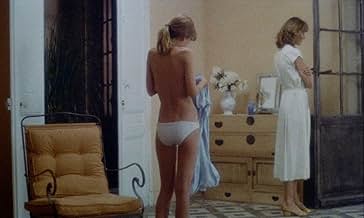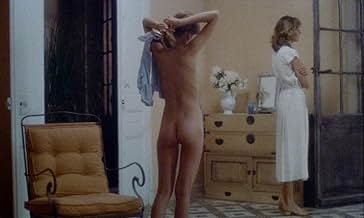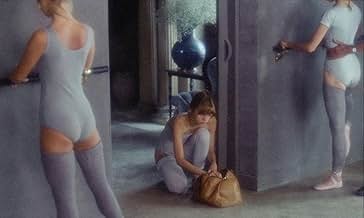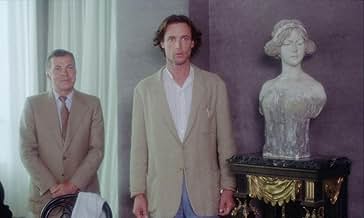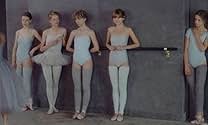CALIFICACIÓN DE IMDb
5.6/10
1.6 k
TU CALIFICACIÓN
El escultor Paul se reencuentra con un antiguo gran amor después de mucho tiempo, pero queda mucho más impresionado por su hija de 15 años, Laura, que se parece a su madre cuando Paul estaba... Leer todoEl escultor Paul se reencuentra con un antiguo gran amor después de mucho tiempo, pero queda mucho más impresionado por su hija de 15 años, Laura, que se parece a su madre cuando Paul estaba enamorado de ella.El escultor Paul se reencuentra con un antiguo gran amor después de mucho tiempo, pero queda mucho más impresionado por su hija de 15 años, Laura, que se parece a su madre cuando Paul estaba enamorado de ella.
- Dirección
- Guionistas
- Elenco
William Milié
- Le chorégraphe
- (as William Millie)
Gunilla Astrom
- Diane
- (sin créditos)
Bernard Daillencourt
- Docteur Benoît
- (sin créditos)
David Hamilton
- Un invité à la réception
- (sin créditos)
Patrick Juvet
- Pianiste
- (sin créditos)
Katia Kofet
- Claudie
- (sin créditos)
Luciano
- Timothez Sega
- (sin créditos)
Michael Pochna
- Gérard
- (sin créditos)
Anja Schüte
- Dancer
- (sin créditos)
- Dirección
- Guionistas
- Todo el elenco y el equipo
- Producción, taquilla y más en IMDbPro
Opiniones destacadas
I have read several technical critiques of this movie over the years, but it they all miss the mark for me, because this film provides something that very few films ever do - a gentle, poignant and tranquil approach into a world where the artistic, feminine and erotic merge in a manner that is generally well conceived and often breathtakingly beautiful.
David Hamilton is first and foremost a fine art photographer, and whilst there may be cinematic errors here, the visual content of the film allows one to pause and consider the wonder of the female form. I am delighted to own a copy of this visual hymn to some of the most delightful aspects of human life.
Howard Nowlan Fine Art Photographer, Cornwall, UK.
David Hamilton is first and foremost a fine art photographer, and whilst there may be cinematic errors here, the visual content of the film allows one to pause and consider the wonder of the female form. I am delighted to own a copy of this visual hymn to some of the most delightful aspects of human life.
Howard Nowlan Fine Art Photographer, Cornwall, UK.
Artists are inspired by myths, and this picture-poem starts with an artist having a visionary view of the birth of Venus. To director David Hamilton this is a look at a woman before life leaves its many marks on her. Both Hamilton and the artist wants to freeze this moment of Adam-and-Eve-innocence, and both do it with sensual devotion. The innocence gets lost on the way, as we all know it will be - but in Hamiltons dream, as well as in his life as photographer, the sensuality not only remains, but grows stronger. Maud Adams shows as mother a strong believe in this, watching her daughter growing up. As the daughter, Laura, sees Dawn Dunlap.
Other comments shows too much interest for the amateurish acting in this picture-poem. As a mirror reflecting a world where we think too much and too little at the same time. We think too much with our senses turned off, and too little with our senses turned on. Brigitte Bardot was once asked by a journalist: "What do you think about free love?" Brigitte Bardot answered: "I don't think when I make love". If Hamilton was asked about his movie-theory for "Laura", he would probably answer: "I don't make movies, I'm just dreaming". The camera catch the dream and makes it possible to share it - and I'm very grateful that it has been possible for me to share Hamilton's dream.
David Hamilton is a child of a time - the 70's - where everybody was searching deep and wide, and he became famous in that time. Men like to see his pictures of girls, but back then it was the mothers who asked him to photograph their daughters. The style in Hamilton's picture-poems was not unusual for European movies in the 70's. A danish movie was inspired by Robert Frost: "The woods are lovely dark and deep / but I have promises to keep / and miles to go before I sleep." Perhaps the meaning in that poem is the reason why Hamilton wants to share his dreams.
Other comments shows too much interest for the amateurish acting in this picture-poem. As a mirror reflecting a world where we think too much and too little at the same time. We think too much with our senses turned off, and too little with our senses turned on. Brigitte Bardot was once asked by a journalist: "What do you think about free love?" Brigitte Bardot answered: "I don't think when I make love". If Hamilton was asked about his movie-theory for "Laura", he would probably answer: "I don't make movies, I'm just dreaming". The camera catch the dream and makes it possible to share it - and I'm very grateful that it has been possible for me to share Hamilton's dream.
David Hamilton is a child of a time - the 70's - where everybody was searching deep and wide, and he became famous in that time. Men like to see his pictures of girls, but back then it was the mothers who asked him to photograph their daughters. The style in Hamilton's picture-poems was not unusual for European movies in the 70's. A danish movie was inspired by Robert Frost: "The woods are lovely dark and deep / but I have promises to keep / and miles to go before I sleep." Perhaps the meaning in that poem is the reason why Hamilton wants to share his dreams.
I agree more or less with all the comments sent so far. This might be surprising, because they seem to be so different. But they are sent from different points of view, and if you try to make a resume, you'll see how it all fits well. Let's make an example: "Glengarry Glen Ross" (or some similar indoor drama) can be described as perfect deep (by drama lovers) or terribly unwatchable slow boring movie (by action lovers); great example how a masterpiece can be made without a single female role (artistic purist statement), or a glorifying men in business and so neglecting women (a feminist statement) or even a pointless flick with no chicks to look at (a macho statement); a movie where authors bravely use words that people use in reality, or a blasphemy with an obscene language that would fit only in NC-17 movie.
I admire and adore Hamilton's work as a photograph. But, yes, being a genius in one art doesn't automatically mean you can make masterpieces in other arts (Barbara Streissand is an exemption). Some great movie photographers made movies (like Nykvist), but they learned job with people like Tarkovsky. Hamilton made only still pictures, and this is what he does best. I think making movies was not a bad idea, but he should have made them as a photographer and leave directing to a professional. Then he could have avoided some real mistakes described in earlier comments. But I wouldn't be too strict. If you don't expect too much his movies won't disappoint you. Of course, if you don't accept nudity, this is not a movie for you, but such audience knows they should avoid Hamilton's work in general. People who believe showing nude young bodies is a sin are entitled to their opinions; but if you believe such a movie could induce child molestation, you should also ban all crime movies, thrillers (not to mention horrors), movies where people smoke, eat fast food, hurt each other in any way, appear in dangerous situations (most adventure movies from Tom Sawyer and Tarzan to Indiana Jones) etc. - such behaving can also be imitated, even more dangerously (there is no violence in Hamilton's movies!). And a man who can't tell reality from a movie is a psychopath who will cross the line of crime sooner or later regardless the movies he watches.
Back to Laura and Hamilton. In Laura he made probably his most beautiful scenes, like Laura going out from the sea, and the opening sequences are his typical. And the scene some don't like, some find controversial, when Laura dances and her mother takes pictures, is a real homage to photography as art. It is an artist-model and not a mother-daughter relation. With a photo (or pencil, or canvas) in his hand an artist leaves his real world, stops being a member of family, race, nation, he creates a new world. Here Hamilton gives us a short lesson of making photos, feeling the light (Hamilton's strongest tool), lines, movements. If a picture paints a thousand words this scene saves a million words if you want to make a documentary about Hamilton himself. And this is where I agree with some of earlier comments, his work talks enough, he should stay behind camera. No words. Less directing.
A film, though with weak script and much too big oscillations in directing, was saved by great acting and again (like in Bilitis) by perfect music. For Hamilton fans - don't expect "La Dance" or "Dreams of a Young Girl", but you'll like it. The others, if not too easily offended, probably won't turn the TV off, but it's also very likely they won't remember it too long.
I admire and adore Hamilton's work as a photograph. But, yes, being a genius in one art doesn't automatically mean you can make masterpieces in other arts (Barbara Streissand is an exemption). Some great movie photographers made movies (like Nykvist), but they learned job with people like Tarkovsky. Hamilton made only still pictures, and this is what he does best. I think making movies was not a bad idea, but he should have made them as a photographer and leave directing to a professional. Then he could have avoided some real mistakes described in earlier comments. But I wouldn't be too strict. If you don't expect too much his movies won't disappoint you. Of course, if you don't accept nudity, this is not a movie for you, but such audience knows they should avoid Hamilton's work in general. People who believe showing nude young bodies is a sin are entitled to their opinions; but if you believe such a movie could induce child molestation, you should also ban all crime movies, thrillers (not to mention horrors), movies where people smoke, eat fast food, hurt each other in any way, appear in dangerous situations (most adventure movies from Tom Sawyer and Tarzan to Indiana Jones) etc. - such behaving can also be imitated, even more dangerously (there is no violence in Hamilton's movies!). And a man who can't tell reality from a movie is a psychopath who will cross the line of crime sooner or later regardless the movies he watches.
Back to Laura and Hamilton. In Laura he made probably his most beautiful scenes, like Laura going out from the sea, and the opening sequences are his typical. And the scene some don't like, some find controversial, when Laura dances and her mother takes pictures, is a real homage to photography as art. It is an artist-model and not a mother-daughter relation. With a photo (or pencil, or canvas) in his hand an artist leaves his real world, stops being a member of family, race, nation, he creates a new world. Here Hamilton gives us a short lesson of making photos, feeling the light (Hamilton's strongest tool), lines, movements. If a picture paints a thousand words this scene saves a million words if you want to make a documentary about Hamilton himself. And this is where I agree with some of earlier comments, his work talks enough, he should stay behind camera. No words. Less directing.
A film, though with weak script and much too big oscillations in directing, was saved by great acting and again (like in Bilitis) by perfect music. For Hamilton fans - don't expect "La Dance" or "Dreams of a Young Girl", but you'll like it. The others, if not too easily offended, probably won't turn the TV off, but it's also very likely they won't remember it too long.
I was 12 when this came out, saw it later in the 80s and currently picked up the dvd at a charity shop and watched it again as an old man lol. It was nice to see something you saw as a young man and look back and realize how simple yet complex being young was in those days, we were kids but thought we were adults at 15, (Dawn was 17 in real life) most of us were experimenting or well past at that age, or at least my crowd was. I remember a few girls in grade 8 that looked 18 that were carrying on with our gym teacher on lunch breaks in his van doing the cheech and chong and get naked routine, (yes Julie L I'm referring to you ha ha)
As far as the movie goes it was all over the place and though it didn't seem to be put together well, it made sense. Some people have commented why the mother sent pics but wouldn't allow him to see Laura, well she wanted him to remember her and tempt him back using Laura's beauty since her marriage was dead. She wanted him for herself until she realized he only loves illusions of women. That's why she wasn't angry at her daughter or Paul when she allowed the daughter to say goodbye to her "ballet friends" but saw him instead before being sent away to school or wherever, mom knew it would be good for her to close that chapter and Paul was innocent enough. Another comment was how did Paul just walk in the ballet class and not get questioned? Well his helper was in the class and invited him along to see the girls, simple. As far as the age gap, looking at it with North American eyes it may seem a little too much, but in France you can drink wine at 12, date older men and it's nothing to look twice at, I think it was a nice slice of coming of age and reminding us we were all nubile and young at one point, we never change totally, just grow older.
As far as the movie goes it was all over the place and though it didn't seem to be put together well, it made sense. Some people have commented why the mother sent pics but wouldn't allow him to see Laura, well she wanted him to remember her and tempt him back using Laura's beauty since her marriage was dead. She wanted him for herself until she realized he only loves illusions of women. That's why she wasn't angry at her daughter or Paul when she allowed the daughter to say goodbye to her "ballet friends" but saw him instead before being sent away to school or wherever, mom knew it would be good for her to close that chapter and Paul was innocent enough. Another comment was how did Paul just walk in the ballet class and not get questioned? Well his helper was in the class and invited him along to see the girls, simple. As far as the age gap, looking at it with North American eyes it may seem a little too much, but in France you can drink wine at 12, date older men and it's nothing to look twice at, I think it was a nice slice of coming of age and reminding us we were all nubile and young at one point, we never change totally, just grow older.
David Hamilton may have made his name as a photographer but Laura leaves his writing and directing abilities with a lot of question marks. The plot and characterisations have holes that you could drive an army through.
When Paul asks if Laura would pose for his new sculpture Sarah refuses so why does she then say that she will take photos of a naked Laura for Paul to use? It's as if she is saying, "No, Mr Wyler, Laura will not pose naked but I will take lots of photos of Laura in erotic poses so that you can ogle her young naked body at your leisure." This is surely not the action of a responsible parent, especially as she knows him well enough not to let Laura anywhere near him. This is evident at a party given by Paul. Sarah, her husband Richard and Laura are invited to the party but Laura is left at home. There are other unanswered questions such as what did the woman at the party want to talk to Paul about and why was Paul allowed access to the ballet school? There is more but it would take too long to go into it all here.
As this is an erotic film centred around art, there is obviously a certain amount of nudity. David Hamilton shows his photographic background by having the ballet students adopting various poses and so looking like living tableaux. There was too much use of fade-to-black and the permanent soft-focus was annoying. This film does not warrant more than 2 stars.
When Paul asks if Laura would pose for his new sculpture Sarah refuses so why does she then say that she will take photos of a naked Laura for Paul to use? It's as if she is saying, "No, Mr Wyler, Laura will not pose naked but I will take lots of photos of Laura in erotic poses so that you can ogle her young naked body at your leisure." This is surely not the action of a responsible parent, especially as she knows him well enough not to let Laura anywhere near him. This is evident at a party given by Paul. Sarah, her husband Richard and Laura are invited to the party but Laura is left at home. There are other unanswered questions such as what did the woman at the party want to talk to Paul about and why was Paul allowed access to the ballet school? There is more but it would take too long to go into it all here.
As this is an erotic film centred around art, there is obviously a certain amount of nudity. David Hamilton shows his photographic background by having the ballet students adopting various poses and so looking like living tableaux. There was too much use of fade-to-black and the permanent soft-focus was annoying. This film does not warrant more than 2 stars.
¿Sabías que…?
- TriviaWhen Laura is in the ballet shower, many of the poses duplicate paintings of Edgar Degas (an artist famed for his ballerina portraits).
- Versiones alternativasThe German cut is ten minutes shorter than the regular version at 85 mins.
Selecciones populares
Inicia sesión para calificar y agrega a la lista de videos para obtener recomendaciones personalizadas
- How long is Laura?Con tecnología de Alexa
Detalles
Contribuir a esta página
Sugiere una edición o agrega el contenido que falta

